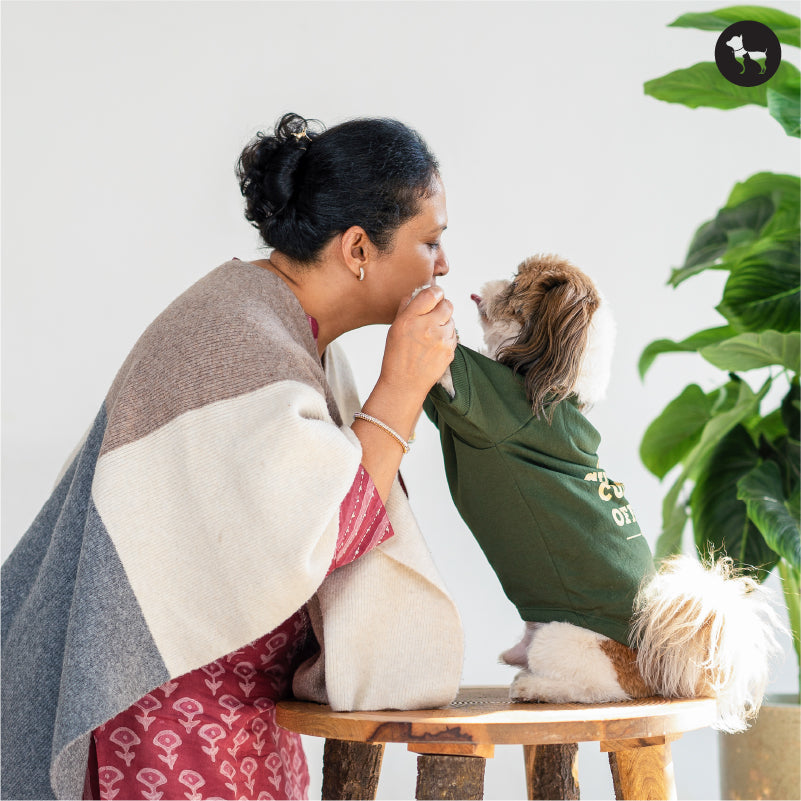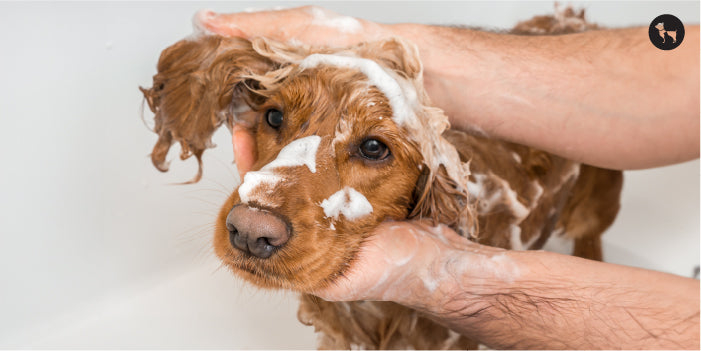
In the treasure chest of my childhood memories, there’s a soft spot for those sunny, winter afternoons when my grandma would oil my hair, part them into two sections and then gently brush them into braids. It wasn’t just the routine that brought peace to the little me, but the tender activity in itself. Grooming our children, so they look and feel their best, has always been a silent act of love in our culture where we seldom use our words to share affection.
When I brought home my dog Bella, I felt blessed when I realised I could bond with her better through the act of grooming. The more I read up about dog grooming, the more I realised there was so much I had no clue about! Were you aware that dog grooming should change as per the season? Or that each dog has three types of fur: undercoat, guard hair and whisker? (Yes, whiskers!) Did you know that our dogs have 1-2 layers of coat, depending on their breed? Or that dog grooming isn’t just about giving fancy dog haircuts but also focussing on their bath, their nails and overall health?
At HUFT, I’ve had the opportunity to be in touch with grooming experts who have been kind enough to share with me their dog grooming tips for winters. It felt only right that I do not gatekeep this knowledge. In this blog, I’ll share with you all that I know about winter dog grooming to ensure your furry companion’s health and happiness.

Winters makes us appreciate all that we’ve had all along, for it can take away so much. For our dogs, while it brings relief from the Indian summers, it also brings with it dry skin and coat, matting and tangled fur (especially in areas where the coat is longer and thicker), cracked paws, increased shedding and even skin infections. Establishing a regular winter dog grooming routine for your furry companion can go a long way in preventing such issues.
The answer is in the question itself - build a routine! Each dog is unique in their own special way and should have a routine tailored to their grooming needs. A good dog grooming tip is to touch base with a vet or a dog groomer to understand what will help your dog. According to us, here’s what a generic dog grooming routine should definitely include:

The best dog grooming tip for the winter season is brushing your dog a few times a week, depending on how much they shed. While this is an all-year essential, it adds a little more to our dog’s happiness in winters. Some dogs experience increased shedding during the winter months as their bodies respond to changes in daylight and temperature. While shedding is a natural process for all dogs, excessive shedding can be a sign of inadequate grooming or an underlying health issue.
Not only does brushing help remove loose fur and prevent matting, it also stimulates blood flow to the skin, promoting a healthy and shiny coat. Plus, who doesn’t enjoy a relaxing massage? There are different dog grooming brushes and combs available for the kind of problem area you’re trying to solve for. Here’s a list of HUFT personal favourites:
HUFT Dog Grooming Tips: How to brush your dog properly?
|

A question I struggled with when I brought home Bella was - Does she need a bath in winters? How frequently should I bathe her?
Dog baths do decrease in winters but it’s essential we do not neglect them completely. Excessive bathing during winters can strip our dog’s skin of natural oils leading to dryness and irritation. What’s needed is a right balance. Limit baths to when necessary, using a gentle moisturising dog shampoo created especially for maintaining their coat’s moisture. I’ve also found using a dog massage brush to be helpful while bathing Bella. It’s relaxing, great for blood circulation and always leaves her coat healthy and thriving.
HUFT Tip: Always dry your dog thoroughly with a microfiber dog towel after bathing, paying particular attention to their paws and between their toes to prevent moisture buildup and potential frostbite.
HUFT Dog Grooming Tips: Do dogs need a spa in winters?Here are 3 reasons why letting your pet experience winter spa can be beneficial:
|

Our dog’s paws are mostly hidden from our eyes which can also mean we might miss out on taking care of them. Walking on cold pavements can cause your dog’s paw pads to become dry and cracked, leading to irritation, pain and discomfort. Harsh winds can also cause their snouts to dry up. In winters, we recommend using a pet-safe healing balm and paw butters which can help keep these areas protected and moisturised. You can also get them winter dog clothes to keep them warm on their walks.
Speaking of paws, it’s important we do not forget to trim our dog’s nails. Start by holding your dog’s paw firmly in a comfortable position. Trim the tip of the nail with a single stroke using a dog nail cutter. Make sure that you do not cut too close to the ‘quick’ of the nail. The ‘quick’ is a soft cuticle that contains blood vessels and nerves that run through your dog’s nails. If you’re unsure how to do this, take your dog to a professional groomer.
HUFT Tip: Nail trimming can be stressful for some pets. You can create a positive association with the activity by rewarding your dog with a yummy dog treat and loving words after each session!
The combination of cold, damp weather and indoor heating can create an environment that’s easily conducive to fungal and bacterial skin infections in dogs. Common types of skin infections are yeast infections, ringworm and bacterial dermatitis. You can spot them by looking for common signs such as redness, inflammation, itching and excessive hair loss. If you suspect your dog has a skin infection, immediately consult with your veterinarian for a proper diagnosis and treatment.
Whether or not your dog needs a haircut in winter depends on their breed and coat type. Dogs with thick or long coats will surely feel some relief with a trim. Dogs also rely on their coats for insulation in the cold weather so make sure you do not trim too far. Regular grooming will help keep your dog’s coat healthy and prevent dry skin and coat. If you’re unsure, you can always reach out to our groomers at our HUFT Spas who can give you their professional opinion.
Start by holding your dog’s paw firmly in a comfortable position. Trim the tip of the nail with a single stroke using a dog nail cutter. Make sure that you do not cut too close to the ‘quick’ of the nail. The ‘quick’ is a soft cuticle that contains blood vessels and nerves that run through your dog’s nail. If you’re unsure how to do this, take your dog to a professional groomer.
Cleaning your dog’s teeth is important year-round, especially in winters. Dental care helps prevent common issues such as plaque and tartar that causes stinky breath and dental issues. Establishing a regular brushing routine using a dog toothbrush and dog toothpaste, along with tasty dental dog treats can help maintain your dog’s oral hygiene, regardless of the season.
Dry skin and coat, matting and tangled fur (especially in areas where the coat is longer and thicker), cracked paws, increased shedding and even skin infections are common in dogs during winters. Establishing a regular winter dog grooming routine for your furry companion can go a long way in preventing such issues.
Walking on cold pavements can cause your dry and cracked paw pads leading to irritation, pain and discomfort. Harsh winds can also cause their snouts to dry up. Hence, we recommend using a pet-safe healing balm and paw butters which can help keep these areas protected and moisturised. You can also get them winter dog clothes to keep them warm on their walks.
Three words - hydrate, hydrate and hydrate! To prevent dry skin in dogs during winter, ensure your dog stays hydrated by providing fresh water and incorporating moisture-rich foods in their diet. Use a gentle, moisturising shampoo during baths. Avoid over-bathing as frequent baths can strip their skin from natural oils. Additionally, you can also give your dog Sardine Oil or Hemp Seed Oil to promote healthy skin and coat.